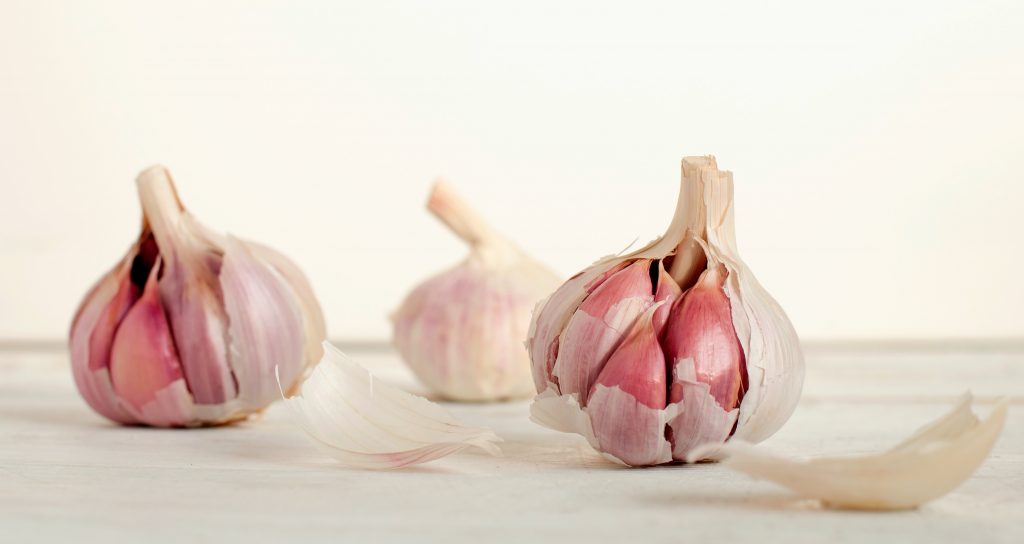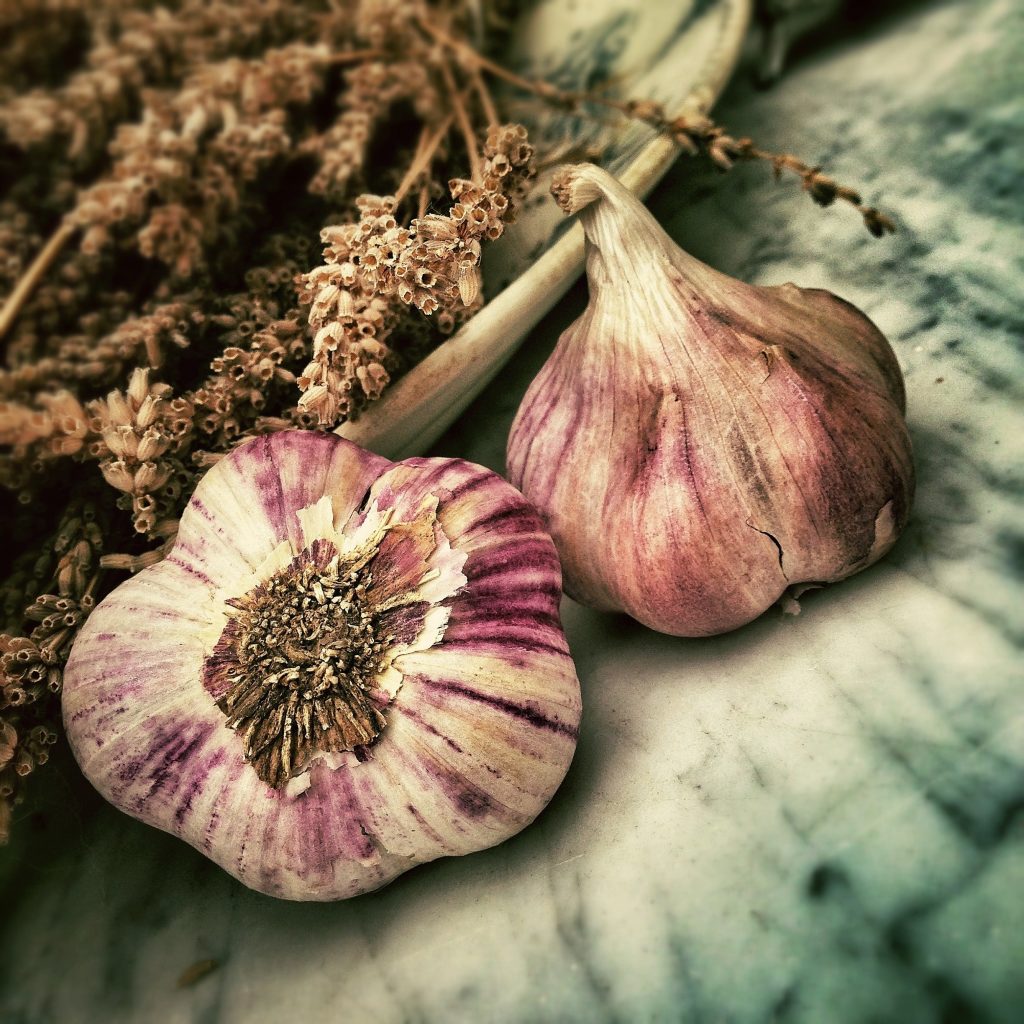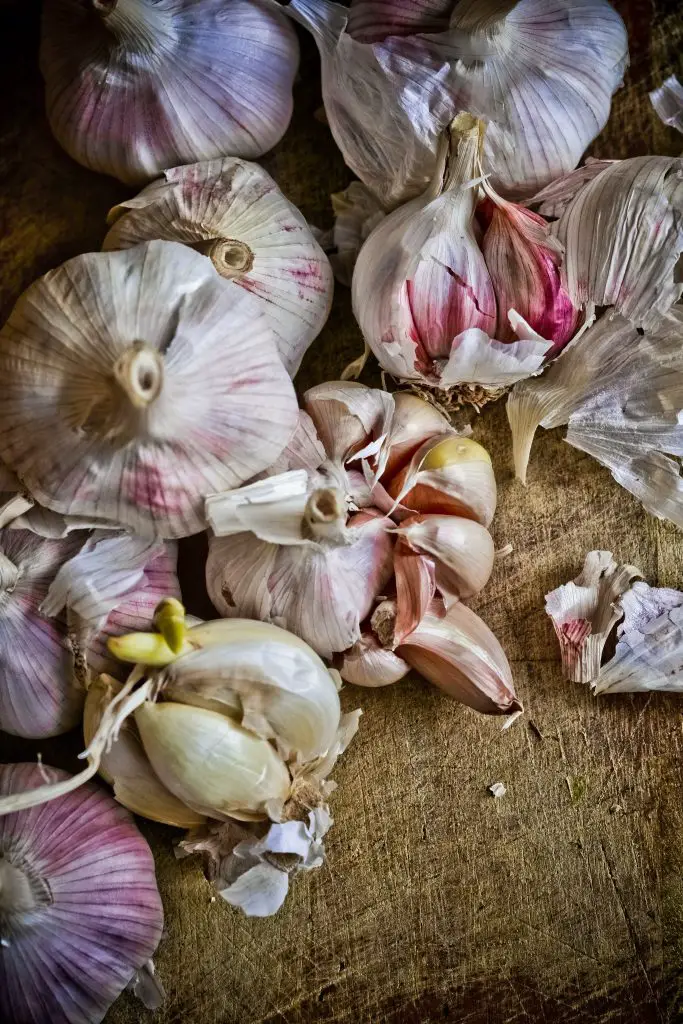Garlic Clove Vs Bulb: Are They The Same Thing? Garlic is one of the most widely used spices in the world which is used in a huge range of dishes. It originated in the middle east and central Asia and has been used for thousands of years in places like ancient Egypt and China. Garlic is sometimes referred to as a clove or a bulb and sometimes even a garlic head. So what is the difference?
A garlic bulb, which is sometimes referred to as a garlic head, is made up of several segments known as cloves. Each clove has its own individual paper-like outer skin and the group of cloves also has a collective outer skin that makes up the bulb. Garlic bulbs typically contain 10 to 12 cloves. The image below shows the structure of a garlic bulb with the white outer skin of the whole bulb and the pink outer skin of the clove.

The pointy section at the top of the bulb is the area where the foliage of the plant once grew and has long since died back leaving a cluster of cloves behind. At the bottom of the bulb there is a basel plant where the roots came out of the plant, on commercially sold garlic these roots are commonly removed from the bulb.
Within the garlic bulb, the structure can vary depending upon the type of garlic being grown. Garlic can generally be divided up into two general main types; Hardneck and Softneck. The “neck” actually refers to the stalk that grows from the garlic bulb. Hardneck varieties have a stalk that hard and rigid and runs through the centre of the bulb.
Softneck garlic also has a central stalk, but it remains relatively soft flexible through the growing period. This is the variety of garlic that most people are familiar with as it is the main variety sold in grocery stores. This type of garlic is preferred by commercial producers because of its relatively long shelf life.
How Are Garlic Bulbs Grown?
New Garlic bulbs can be produced by breaking apart the bulb and planting individual cloves into the ground, however, to create a segmented bulb like the one found that the clove originally comes from the garlic needs to be planted in Autumn. Planting cloves in spring will produce significantly different results.
For the new planted cloves to produce a new, individually segmented cloves of its own it needs to be exposed to a period of cold. This period of cold will force the garlic bulb to be divided into separate cloves in a process known as vernalization.
If you plant the cloves in spring the cloves will still grow and produce green shoots that can be used in cooking to flavor dishes but the garlic cloves cannot be collected for replanting the following year. To read more about this click here.

Can You Plant Cloves From The Grocery Store?
The store brought garlic can be used to grow your own garlic however the results that you will get generally won’t be as good as what you will get if you purchase garlic bulbs from a plant specialist. I personally would recommend purchasing garlic bulbs which are essentially a one-off purchase provided that you save bulbs to replant every year.
To make sure that I don’t need to re-buy garlic I put aside the biggest and best bulbs for next year. You will typically produce 10 to 12 bulbs per bulb saved. For a family of 5, I typically save 6 to 8 bulbs which goes close to supplying my garlic needs for the year.
However, if you want to go down the path of planting cloves from the supermarket it may be worth having a look at a trial conducted by the well-known market gardener Charles Dowding which show what happens.
How To Grow Garlic
Irrespective of where you choose to grow garlic from store brought bulbs or from those purchased from a plant specialist, the process is the same. Start by breaking the garlic up into individual cloves and discard any really small cloves as they will not produce decent-sized bulbs.
When planting the cloves selecting a warm sunny location, that gets at least 6 hours of direct sun a day. When selecting a location avoid planting the clove in a relatively wet location, as there is a risk that it can rot. The plants should ideally be placed in rich, moist but well-drained soil.
In terms of spacing, cloves should be ideally placed spaced at least 10 inches (20 cm) apart as this will allow a dutch hoe to be used to remove the weeds much more quickly and easily than hand weeding.
The bulbs themselves should be planted at a depth of approximately 1 inch (2 to 3 cm) with the pointy end of the clove facing upward. It is also important to note that it is not necassary to peel the garlic clove and any garlic cloves that have started to produce a shoot before they go into the ground are sill fine to plant.
In cold regions where the ground freezes the timing of the planting in Autumn is critical as the garlic needs to be planted early enough to allow the new roots of the clove to become established before the big freeze arrives, but not so early that the top growth develops too much. When foliage is destroyed by cold weather it will re-grow without any negative impacts, however, if this event occurs more than once due to too much top growth, the yield achieved will be decreased significantly.
The general rule that I apply is plant garlic 2 to 3 weeks after the first frost before the ground begins to freeze. Note: That garlic can wihstand temperatures as low as -30°F (-35°C).
You will not see any growth until the weather starts to warm up in early spring. At this stage the green shoots will appear relatively quickly and will typically reach a height of 6 to 10 inches (15 to 25 cm). During this period there is very little maintenance required apart from giving the plants a bit of a water and ensuring that the garlic is kept weed free.
As the garlic is approaching the point at which it can be harvested, which is typically in late spring, the foliage will start to yellow and die back. At this point the garlic can be dug up and removed from the soil.

How To Use And Store Garlic
Once the garlic has been harvested it is important to ensure that any additional dirt is removed from the bulb before laying it out to dry in a warm location for around 2 weeks. The bulbs can then be stored in a dark cool location that is well ventilated. The ideal container to store bulbs in is a hessian sack.
If stored in these conditions softneck garlic will store for 9 to 12 months whereas hardneck garlic will only store for 6 months or so. To learn more about the ideal storage conditions, additional details can be found in the article by the University of California.
The alternative to storing garlic method to store Garlic is to freeze it. This can be done by freezing whole cloves (peeled or unpeeled) or freezing Minced Garlic. To learn more about this, go to https://feelgoodfoodie.net/recipe/freezing-garlic/.

